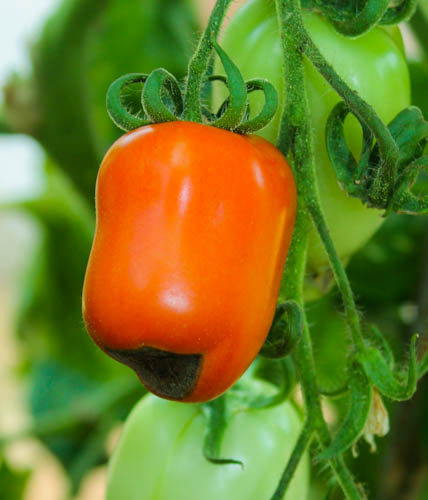
I’ve been having one or two problems with Blossom End Rot, where the end of tomatoes becomes circular, black and flattened. It occurs in peppers and aubergines, squashes and watermelons but is most often seen in tomatoes and is caused by lack of calcium in the fruits. Plants growing in soil, growing bags and potting composts rarely lack calcium but they often lack a good flow of water for it to reach the outer parts of the plant – it doesn’t get much further away from the roots than the fruits, particularly those near the top of the plant. Plants limited rooting space in pots and growing bags are most likely to have problems, along with those growing in acidic conditions while plants in borders – greenhouse or outdoors are less likely to suffer. Adding fertiliser to dry soil or compost can cause problems, too because concentration of nutrients in the soil water restricts moisture uptake by the plant. Nutrients like ammonia compete with calcium for space on the plant roots, which causes further uptake problems and high air humidity can also limit water uptake.
To reduce the chance of Blossom End Rot, keep the greenhouse well ventilated, keep the soil consistently moist at all times, through the growing season, watering twice a day if needed when the weather is particularly hot. It is particularly important when using growing bags as the compost is very difficult to moisten once it has dried out. Automatic watering systems, larger pots up to 37.5cm in diameter, or growing in border soil are all helpful, especially where frequent watering is not possible and mulching around the roots helps, too. Liquid fertiliser must only be applied to moist soil, according to the manufacturer’s instructions. You can still eat the tomatoes even if they have Blossom End Rot – just slice off the damaged tissue. Next year they’ll be back in the border.
Continue sowing ‘cut and come again’ crops in pots, like mixed herbs; mixed salads can be started under the greenhouse benching then moved outdoors.
Keep an eye on watering, it is particularly important as temperatures start to rise. Stand watering cans in the greenhouse for 24 hours so the water warms before use. Fruiting crops like cucumbers, aubergines and tomatoes need a constant supply of water, feed with high potash tomato fertiliser, too.
Make arrangements for someone to check on your greenhouse before going on holiday, thanking them for their efforts by letting them harvest your crops. Regular harvesting ensures continuous cropping. Allow ripened fruits to stay on the plant and they will deteriorate and the plants will stop producing, too.
Ventilate and shade throughout the day. If temperatures are in danger of getting too high, use your greenhouse fan to circulate the air, plants that are easy to move can be placed outdoors in shade.
If you haven’t done so already, sow Foxgloves, Hollyhocks, Canterbury bells, and Delphiniums in a cool greenhouse for planting out and overwintering in October, sow them in cold frames or outdoors further south.
Happy gardening. Matt


